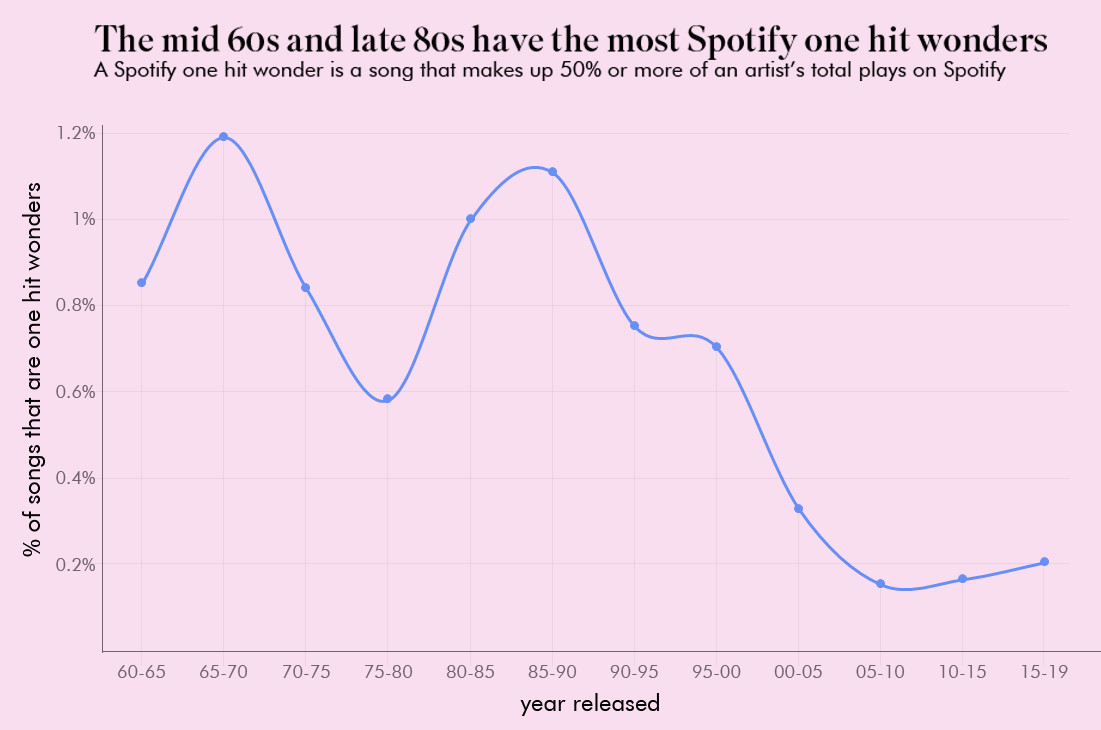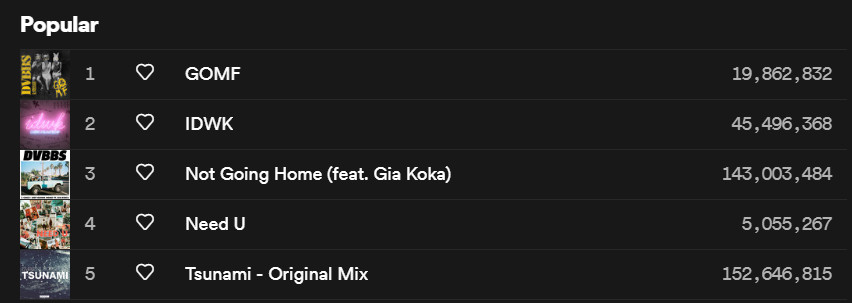One-hit wonder songs hold a unique place in music history, sparking debates and nostalgic trips down memory lane. While many analyses focus on chart performance from decades past, this exploration takes a different approach. We delve into the world of streaming data, specifically Spotify, to uncover the biggest one-hit wonders based on current listening habits. Which songs truly define an artist’s legacy in the streaming age, overshadowing their entire discography? Let’s dive into the data to find out.
Defining a One-Hit Wonder in the Streaming Era
Traditional definitions of a one-hit wonder often revolve around fleeting chart success and subsequent obscurity. However, in the era of streaming, we can measure impact in a new way: by examining listening data. This analysis leverages Spotify data to identify one-hit wonders based on a simple yet powerful metric: the proportion of an artist’s total plays attributed to a single song.
For this investigation, an artist is considered for analysis if they have surpassed 100 million total plays on Spotify – a benchmark ensuring substantial overall popularity. Then, a “one-hit wonder song” is defined as a track that accounts for 50% or more of an artist’s total Spotify plays. This threshold signifies that one particular song is not just popular, but demonstrably more popular than the rest of the artist’s entire catalog combined in current listening trends. This data-centric definition offers a fresh perspective on what constitutes a one-hit wonder in today’s music landscape.
The Data Behind the Discoveries
To embark on this data-driven journey, a robust dataset was essential. Spotify’s comprehensive music library and accessible API made it the ideal platform for this analysis. The process began by compiling an extensive list of artists.
Initially, a substantial list of approximately 80,000 artists was sourced from Kaggle. To ensure comprehensiveness, this list was expanded by leveraging Spotify’s API to gather related artists. For each artist in the initial list, the top 20 related artists were retrieved. After removing duplicates, this process ballooned the dataset to roughly 180,000 artists, capturing a vast spectrum of musical talent.
To further refine the list and capture potentially overlooked one-hit wonders, a manual approach was also employed. Around 20 Spotify playlists specifically curated for “One Hit Wonders” were identified. Artists from these playlists and their related artists (up to five degrees of separation) were added to the dataset. This iterative approach added a few thousand more artists, ensuring that the dataset was as exhaustive as possible.
The final dataset, initially exceeding 180,000 artists, was streamlined by filtering out artists with fewer than 1,000 total followers. This reduced the dataset to a more manageable 40,000 artists, focusing on those with a significant, albeit potentially niche, following.
Next came the crucial step of gathering listening data. While Spotify doesn’t directly provide public play counts for every song, a resourceful developer on GitHub created an API to extract this data from the Spotify desktop client. Utilizing this tool, play counts for over 7 million songs were collected, forming the backbone of this one-hit wonder analysis.
 Line chart showing the percentage of one-hit wonder songs per year on Spotify, highlighting the 60s and 80s peaks.
Line chart showing the percentage of one-hit wonder songs per year on Spotify, highlighting the 60s and 80s peaks.
Decades of One-Hit Wonders: A Temporal Analysis
With the data compiled and the definition established, the analysis turned to identifying trends over time. By calculating the percentage of songs qualifying as Spotify one-hit wonders for each year of release, a revealing pattern emerged.
The 1960s and 1980s stand out as the decades with the highest proportion of Spotify one-hit wonders. This finding resonates with anecdotal perceptions, but interestingly, it diverges from a Billboard analysis which, using a more traditional chart-based definition, concluded that the 1980s actually had the fewest one-hit wonders.
This discrepancy likely stems from the difference between historical chart performance and contemporary listening habits. The Billboard analysis reflected song popularity at the time of release, whereas this Spotify analysis reflects current listening data. The enduring perception of the 80s as a decade of one-hit wonders might be self-reinforcing; listeners may primarily engage with the hits they remember, neglecting the deeper catalogs of these artists.
However, this explanation doesn’t fully account for the lower one-hit wonder percentages in the mid-to-late 1970s, a period also rich in remembered hits. Notably, years prior to 2000 generally exhibit a higher prevalence of Spotify one-hit wonders compared to more recent years. This suggests a possible “forgetting curve” for less prominent songs from older eras, where only the most memorable tracks endure in collective listening habits. Further research into individual listener data could provide deeper insights into these temporal trends.
Genre Deep Dive: Where Do One-Hit Wonders Thrive?
Spotify’s genre classification is known for its extensive and granular nature. To analyze genre-specific trends in one-hit wonders, the analysis focused on the top 25 most popular genres as defined by Every Noise at Once, a project that meticulously catalogs Spotify genres. This selection ensured a focus on broadly recognized and well-defined musical categories, avoiding overly obscure or niche genres.
 Bar chart displaying the proportion of one-hit wonder artists across various music genres on Spotify, with soft rock genres at the top.
Bar chart displaying the proportion of one-hit wonder artists across various music genres on Spotify, with soft rock genres at the top.
Across the median genre, approximately 8% of artists qualify as Spotify one-hit wonders. However, certain genres exhibit a significantly higher propensity for this phenomenon. Unsurprisingly, soft rock and related genres, such as mellow gold and adult standards, top the list. A remarkable quarter of artists in these categories have one song that accounts for more than half of their total Spotify plays. This striking finding suggests that the “one-hit wonder” label is particularly prevalent within these genres, perhaps due to the specific nature of their popularity or the listening habits of their audiences.
Unveiling Spotify’s Ultimate One-Hit Wonders
To pinpoint the “biggest” one-hit wonders on Spotify, the analysis focused on identifying songs that represent the highest percentage of an artist’s total plays (among artists exceeding 100 million total plays).
Identifying the top contenders required careful data cleaning. A peculiar anomaly in Spotify’s data emerged: identical play counts were often attributed to different versions of the same song, particularly remixes or covers. For instance, a remix of the EDM hit “Tsunami” by an artist named Lea in the Mix displayed the same massive play count as the original by DVBBS and Borgeous.
 Screenshot of Spotify showing play counts for Lea in the Mix's remix of Tsunami, used to illustrate data inconsistencies.
Screenshot of Spotify showing play counts for Lea in the Mix's remix of Tsunami, used to illustrate data inconsistencies.
 Screenshot of Spotify displaying play counts for the original version of Tsunami by DVBBS and Borgeous, highlighting data parity with the remix.
Screenshot of Spotify displaying play counts for the original version of Tsunami by DVBBS and Borgeous, highlighting data parity with the remix.
To address this data artifact, a judgment call was made to exclude these likely misattributions. After manually filtering out these instances, a curated list of the top 25 Spotify one-hit wonders was compiled. A Spotify playlist was created to showcase these tracks, allowing listeners to experience this collection of definitive one-hit wonders firsthand.
 Playlist cover image titled 'One Hit Wonders' on Spotify, featuring a collection of songs identified as top one-hit wonders.
Playlist cover image titled 'One Hit Wonders' on Spotify, featuring a collection of songs identified as top one-hit wonders.
Perhaps unsurprisingly, Norman Greenbaum’s “Spirit in the Sky” claimed the top spot, a testament to its enduring appeal. However, equally intriguing were the artists who didn’t make the list. The data revealed that Lil Nas X, despite the monumental success of “Old Town Road,” has a broader catalog that is actively listened to. Similarly, a-Ha, often perceived as a one-hit wonder, also falls outside this categorization based on Spotify data, echoing findings from other analyses.
This data-driven exploration of Spotify listening habits provides a unique lens through which to examine the phenomenon of one-hit wonder songs. While not analytically complex, the process of gathering and cleaning the data offered valuable insights into contemporary music consumption and the enduring legacy of these iconic tracks. The simple, visually engaging presentation of the findings mirrors the catchy and accessible nature of the one-hit wonders themselves, inviting further exploration and discussion.
